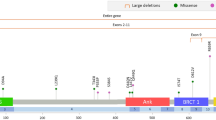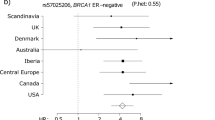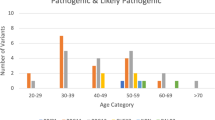Abstract
Mutations in the BRCA1 gene, discovered in 1994, are associated with an 80–90% lifetime risk of breast cancer. We have analysed 60 families with a history of breast and/or ovarian cancer for germline mutations in BRCA1. Twenty–two different mutations were detected in 32 families (53%), of which 14 are previously unreported. We observed a significant correlation between the location of the mutation in the gene and the ratio of breast to ovarian cancer incidence within each family. Our data suggest a transition in risk such that mutations in the 3′ third of the gene are associated with a lower proportion of ovarian cancer. Haplotype analysis supports previous data which suggest some BRCA1 mutation carriers have common ancestors; however, we have found at least two examples where recurrent mutations appear to have arisen independently.
This is a preview of subscription content, access via your institution
Access options
Subscribe to this journal
Receive 12 print issues and online access
$209.00 per year
only $17.42 per issue
Buy this article
- Purchase on Springer Link
- Instant access to full article PDF
Prices may be subject to local taxes which are calculated during checkout
Similar content being viewed by others
References
Easton, D.F., Bishop, D.T., Ford, D., Cockford, G.R. the Breast Cancer Linkage Consortium. Genetic linkage analysis in familial breast and ovarian cancer. Am. J. hum. Genet. 52, 718–722 (1993).
Easton, D.F., Ford, D., Bishop, D.T. the Breast Cancer Linkage Consortium. Breast and ovarian cancer incidence in BRCA1-mutation carriers. Am. J. hum. Genet. 56, 265–271 (1995).
Smith, S.A., Easton, D.F., Evans, D.G.R. & Ponder, B.A.J. Allele losses in the region 17q 12–21 in familial breast and ovarian cancer involve the wild-type chromosome. Nature Genet. 2, 128–131 (1992).
Miki, Y. et al. A strong candidate for the breast and ovarian cancer susceptibility gene BRCA1 Science 266, 66–71 (1994).
Futreal, P.A. et al. BRCA1 mutations in primary breast and ovarian carcinomas. Science 266, 120–122 (1994).
Castilla, L. et al. Mutations in the BRCA1 in families with early onset breast and ovarian cancer. Nature Genet. 8, 387–391 (1994).
Simard, J. et al. Common origin of BRCA1 mutations in Canadian breast and ovarian cancer families. Nature Genet. 8, 392–398 (1994).
Friedman, L.S. et al. Confirmation of BRCA1 by analysis of germline mutations linked to breast and ovarian cancer in ten families. Nature Genet. 8, 399–404 (1994).
Shattuck-Eidens, D. et al. A collaborative survey of 80 mutations in the BRCA1 breast and ovarian cancer susceptibility gene. J. Am. med. Assoc. 273, 535–541 (1995).
Hogervorst, F.B.L. et al. Rapid detection of BRCA1 mutations by the protein truncation test. Nature Genet. 10, 208–212 (1995).
Struewing, J.R. et al. Detection of eight BRCA1 mutations in 10 breast/ovarian cancer families, including 1 family with mate breast cancer. Am. J. hum. Genet. 57, 1–7 (1995).
Tonin, P. et al. BRCA1 mutations in Ashkenazi Jewish women. Am. J. hum. Genet. 57, 189 (1995).
Streuwing, J.R. et al. The carrier frequency of the BRCA1 185delAG mutation is approximately 1 percent in Ashkenazi Jewish individuals. Nature Genet. 11, 198–200 (1995).
Shen, J.C., Rideout, W.M. III & Jones, P. A. High frequency mutagenesis by a DNA methyrtransferase. Cell 71, 1073–1080 (1992).
Wooster, R. et al. Localisation of a breast cancer susceptibility gene, BRCA2, to chromosome 13q12–13. Science 265, 2088–2090 (1994).
Narod, S. et al. An evaluation of genetic heterogeneity in 145 breast-ovarian cancer families. An. J. hum. Genet. 56, 254–264 (1995).
Steichen-Gersdorf, E. et al. Familial site-specific ovarian cancer is linked to BRCA1 on chromosome 17q12–21. Am. J. hum. Genet. 55, 870–875 (1994).
Weissenbach, J. et al. A second generation linkage map of the human genome. Nature 359, 794–801 (1992).
Neuhausen, S.L. et al. A P1 -based physical map of the BRCA1 region from D17S766 to D17S78. Hum. motec. Genet. 3, 1919–1926 (1995).
Goldgar, D.E. et al. A large kindred with 17q-linked breast and ovarian cancer genetic, phenotypic and genealogic analysis. J. natnl. Cancer Inst. 86, 200–209 (1994).
Beaudet, A.L. & Tsui, L-C. A suggested nomenclature for designating mutations. Hum. Mut. 2, 245–248 (1989).
Author information
Authors and Affiliations
Rights and permissions
About this article
Cite this article
Gayther, S., Warren, W., Mazoyer, S. et al. Germline mutations of the BRCA1 gene in breast and ovarian cancer families provide evidence for a genotype–phenotype correlation. Nat Genet 11, 428–433 (1995). https://doi.org/10.1038/ng1295-428
Received:
Accepted:
Issue Date:
DOI: https://doi.org/10.1038/ng1295-428



